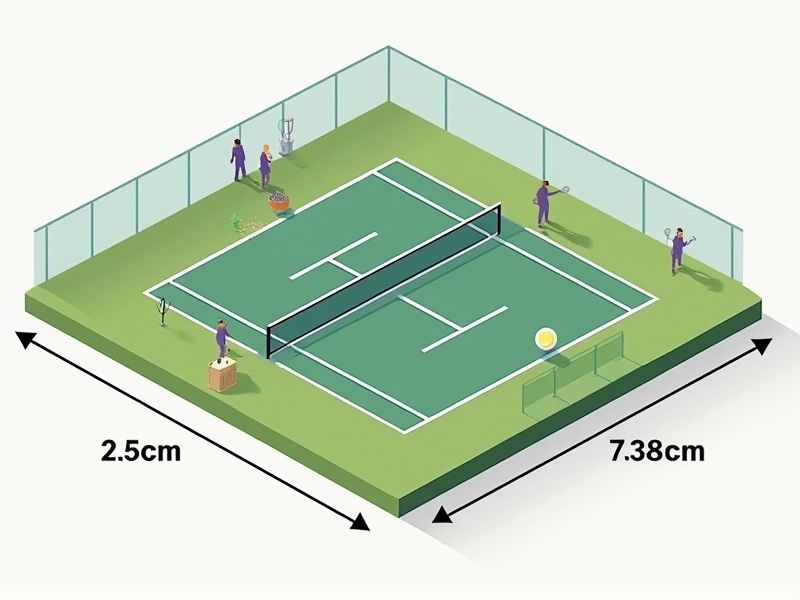
The standard dimensions of a tennis court are carefully regulated to ensure fair play. According to the International Tennis Federation (ITF), a singles tennis court measures 78 feet (23.77 meters) in length and 27 feet (8.23 meters) in width, while a doubles court is the same length but wider at 36 feet (10.97 meters). The net stands 3 feet (0.914 meters) high at the center, extending across the full width of the court. Knowing these dimensions helps players and organizers set up their courts correctly, supporting consistent and enjoyable gameplay for everyone involved.
Singles Court Length
A standard singles tennis court measures 78 feet in length. This specification is essential to ensure consistency in professional matches and player performance. The width of a singles court is 27 feet, optimizing space for two players to engage in competitive rallies. Understanding these dimensions is crucial for anyone looking to build or measure a regulation tennis court.
Doubles Court Width
The standard width of a doubles tennis court is 36 feet (10.97 meters), which is wider than the singles court width of 27 feet (8.23 meters). This additional width allows for a more dynamic play style, accommodating teams of two players on each side. The regulation dimensions specify that the total court length remains 78 feet (23.77 meters) for both singles and doubles matches. Knowing these measurements is essential for maintaining proper court setup and compliance with the official rules of the game.
Service Line Distance
A standard tennis court features a service line positioned 21 feet (6.4 meters) from the net, creating a critical boundary for services. This line separates the service area, influencing both player strategy and service dynamics. Knowledge of this distance aids in mastering service placement and court positioning, essential skills for competitive play. Understanding the service line's role enhances your overall game strategy and performance on the court.
Baseline Width
The standard width of a tennis court baseline measures 27 feet (8.23 meters) for both singles and doubles play. This area is crucial as it delineates the boundary for playable shots and influences players' positioning and strategies during a match. Proper conditioning of the baseline, including surface material and maintenance, contributes to consistent ball bounce and performance quality. Ensuring that your court complies with these dimensions can significantly enhance the playing experience.
Net Height At Posts
The standard net height for a tennis court at the posts is 3.5 feet (1.07 meters). This measurement ensures consistency across all tennis facilities, allowing players to experience uniform playing conditions. The center net height, which dips to 3 feet (0.91 meters), is essential for maintaining proper gameplay dynamics. Proper installation of net posts, maintaining this height, contributes significantly to the overall quality and fairness of the match.
Net Height At Center
The official net height at the center of a standard tennis court is precisely 0.914 meters (3 feet). This regulation ensures fair play, as it establishes a uniform barrier that separates opponents during matches. For singles matches, the court dimensions are 23.77 meters (78 feet) in length and 8.23 meters (27 feet) in width, while doubles courts extend to 10.97 meters (36 feet) in width. Proper maintenance of these measurements, including the net height, is essential for competitive play and adherence to international guidelines.
Center Mark Placement
Proper placement of the center mark on a standard tennis court is crucial for maintaining fair gameplay. The center mark is precisely located 21 feet (6.4 meters) from the baseline, ensuring a symmetrical service area for both players. This 4-inch (10 cm) long mark runs perpendicular to the baseline, helping you align your serves and groundstrokes efficiently. Accurate center mark placement enhances competitive integrity, allowing players to assess positioning during critical points in the match.
Service Box Dimensions
The service box on a standard tennis court is divided into two equal parts, each measuring 21 feet (6.4 meters) in length and 13.5 feet (4.1 meters) in width. This area sits within the larger dimensions of the court, which is 78 feet (23.77 meters) long and 36 feet (10.97 meters) wide for doubles play. The service boxes are essential for defining where players must serve the ball legally into play, ensuring the server follows the rules regarding foot placement and ball landing. Understanding these dimensions is crucial for improving your game, as positioning within the service box can significantly influence your serve's effectiveness and accuracy.
Alley Width For Doubles
The standard width of the doubles alley on a tennis court measures 4.5 feet (1.37 meters) on each side of the court. This brings the total width of the doubles court to 36 feet (10.97 meters). The alley serves as a crucial zone during doubles play, allowing players to utilize different angles and strategies. Ensuring your court meets these dimensions can enhance gameplay quality and compliance with official regulations.
Baseline To Net Distance
The official distance from the baseline to the net on a regulation tennis court measures 21 feet (6.4 meters) for singles and doubles play. This space ensures optimal gameplay dynamics, allowing for a balance of power and strategy. The total length of a standard tennis court is 78 feet (23.77 meters), further emphasizing the importance of this critical distance. Understanding this measurement can enhance your awareness of court positioning during matches.
